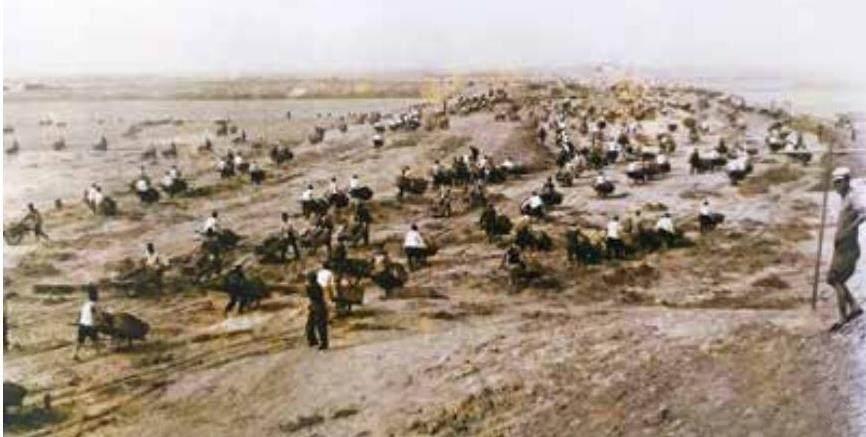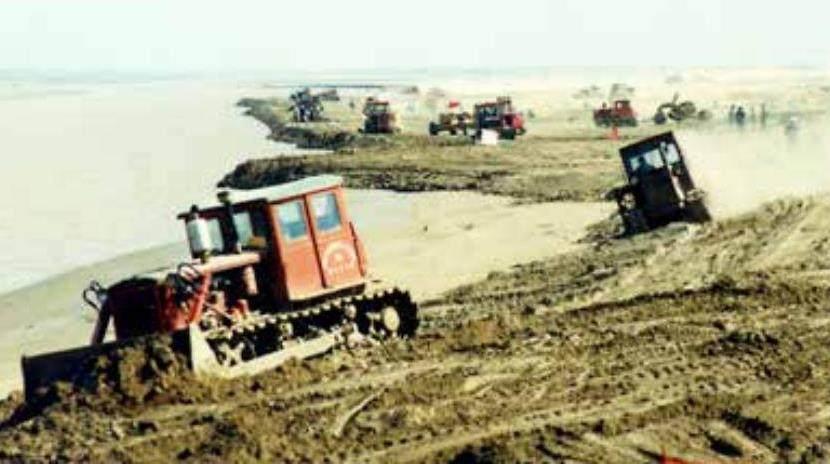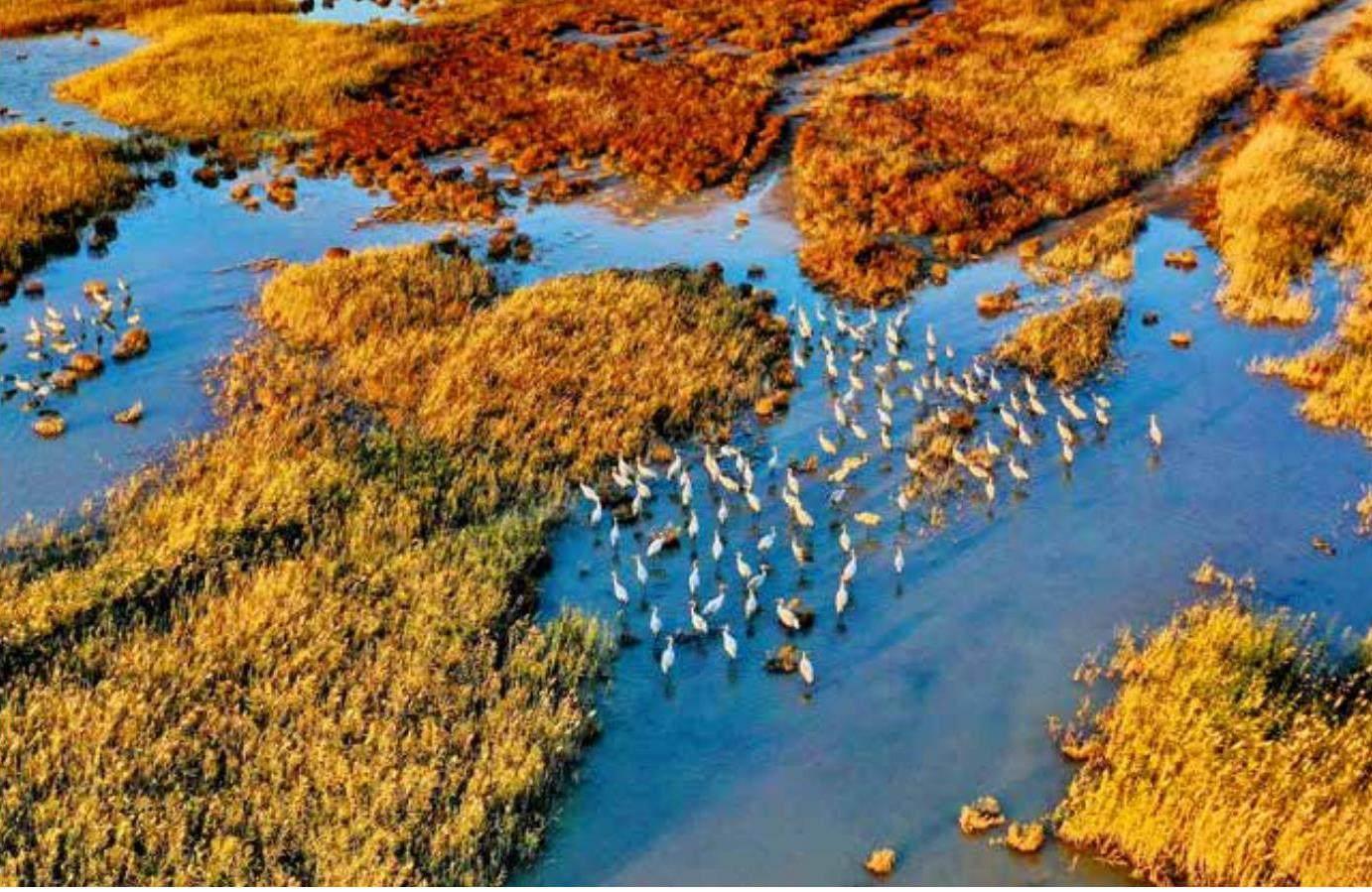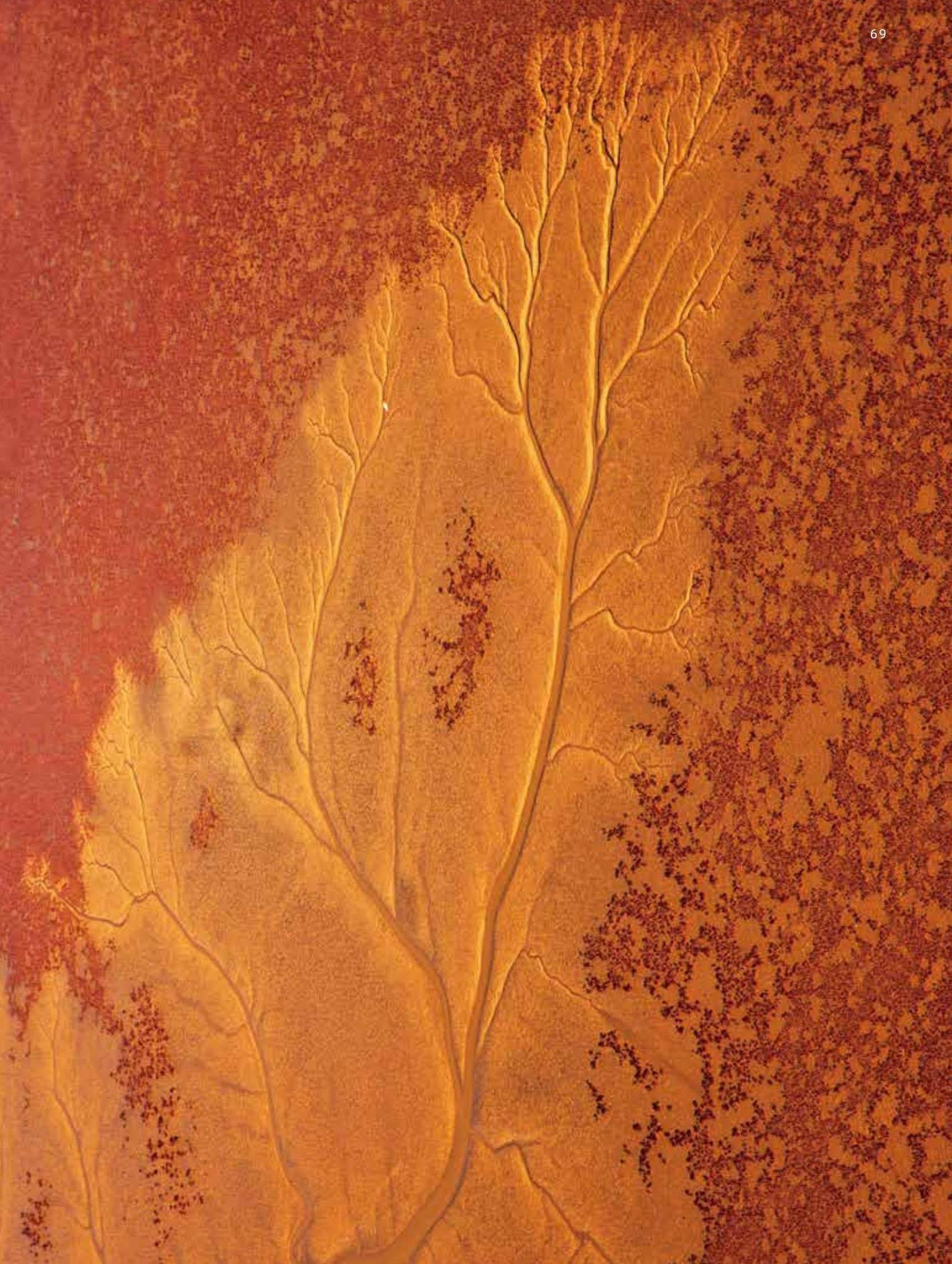黄河入海流 The Yellow River’s Flow into the Sea
2024-03-04李中锋LiZhongfeng
李中锋 Li Zhongfeng






“白日依山尽,黄河入海流。欲穷千里目,更上一层楼。”唐代诗人王之涣的经典诗作《登鹳雀楼》,在中国几乎是家喻户晓、人人皆知。但是,“黄河入海流”的现实场景和历史事件,却远非诗词中表述的那么美。
“Under the s e tting sun, themountains extend endlessly, and theYellow River meets the sea. To explorea thousand miles of scenery more,ascend yet another floor.” These linesare from the timeless Tang Dynastypoem “On the Stork Tower” by WangZhihuan. While the verses are cherishedthroughout China, the reality andhistory of the Yellow River flowinginto the sea is quite different from thepicturesque beauty depicted in thepoem.
历史上的黄河曾“三年两决口,百年一改道”。黄河河道北至天津,南至淮河,在广袤的中国华北地区长期大幅度摆动、游荡,既塑造了华北大平原,也扰乱了生活在这一地区的人们。古代典籍中就多见对黄河流域水灾、旱灾、蝗灾及由此造成的百姓饥荒、灾民迁移及社会动乱等的相关记载。
Throughout history, the YellowRiver would “burst its banks every twoyears and change its course once everycentury.” These shifts have led the riverto meander from as far north as Tianjinto as far south as the Huai River, carvingits path through the expansive NorthChina region. While this geologicalphenomenon has shaped the NorthernChina Plain, it has also disruptedthe lives of its inhabitants. Historicalaccounts are filled with stories of floods,droughts, locust plagues in the YellowRiver basin and the subsequent famines,mass migrations, and social upheavals.
有資料记载,在1855年以后的100多年间,黄河三角洲发生的决口漫溢达87次,其中大的河口改道就有九次,平均十年左右入海路径就会变化。频繁的河道更改,将当地人常说的“三十年河东,三十年河西”这一谚语改为“十年河东,十年河西”。“大孤岛,人烟少,年年洪水撵着跑。”这个顺口溜更是人们对于昔日黄河入海的形容。
According to historical records, in the periodspanning over 100 years from 1855, the Yellow RiverDelta witnessed 87 instances of flooding and ninesignificant alterations in the river’s mouth, leading toa shift in its path approximately every ten years. Thesefrequent changes transformed a local saying from“thirty years east of the river, thirty years west of theriver” to “ten years east of the river, ten years west ofthe river.” Another popular rhyme, “Gudao Island issparsely inhabited, and every year the floods force usto move,” vividly illustrates the historical patterns ofthe Yellow River’s flow into the sea.
20世纪60年代初,在山东省广饶县的东营村和垦利县的胜利村打出了新油井,这些油井在1965年被命名为“胜利油田”。随着这些油田的发展和黄河三角洲的开发建设,东营市在1982 年底获准成为省辖地级市。
In the early 1960s in Shandong, new oil wellswere discovered in Dongying Village, GuangraoCounty, and Shengli Village, Kenli County. These oilwells were collectively named “Shengli Oil Field” in1965. As these oil fields developed and the overalltransformation of the Yellow River Delta progressed,Dongying gained prefecture-level city status by theend of 1982.
城市建设、人民生活、油田生产、黄河三角洲生态保护等,这些都需要一个稳定的环境。黄河入海的流径频繁摆动,洪汛、凌汛时常带来的灾难损失,成为胜利油田与东营市面临的一个最严峻的问题。“东营拓荒千宗事,稳定河口第一桩。”稳定河口,既是防洪防凌保石油生产的需要,也是东营市人民生活稳定的保障。
Urban development, people’s livelihoods, oilfieldproduction, and ecological preservation in the YellowRiver Delta all depend on a stable environment. Thefrequent shifts in the Yellow River’s course and thedisasters brought by its floods and ice jams have becomeone of the most pressing challenges for Shengli Oil Fieldand Dongying City. “Of Dongying’s various pioneeringtasks, stabilizing the river mouth is of paramountimportance.” This stability is not only crucial forpreventing floods and ice jams in oil production but alsoessential for ensuring the residents’ overall quality of life.
1976—1986年,黄河入海主要以清水沟为主,并且行水了十年。按当地流行的顺口溜及当时的水流情况,也到了需要改道的时间。
From 1976 to 1986, the primary outlet for theYellow River into the sea was Qingshuigou, and itflowed steadily for a decade. However, it became clearthat a change in course was necessary, consideringlocal knowledge and the prevailing water conditionsat the time.
然而,改道的損失和代价是非常巨大的。如果北向改道,胜利油田投资18亿元建成的一座年产500万吨原油的孤东大油田和原孤岛油田都将面临被冲毁的危险。1988年5月,政府下达了黄河改道北股的决定。当时的油田生产办公室工作人员按捺不住心中的愤慨:“改道北股,刚刚建成的年产500 万吨的孤东油田就要被冲走。你们破吧!我就躺在这里,叫黄河水冲走!”
However, the challenges and expenses associatedwith altering the river’s course were substantial.Redirecting the river northward posed a risk ofdamaging the newly constructed Guodong Oil Field,which had an annual production capacity of fivemillion tons of crude oil, as well as the original GudaoOil Field. In May 1988, the government decided toredirect the northern branch of the Yellow River, adecision met with frustration among the oilfield staff.One person exclaimed, “Redirecting the northernbranch means that the newly built Gudong Oil Fieldwith an annual production capacity of five million tonsis about to be washed away. While you go ahead, I’ll justlie here and let the Yellow River water carry me away!”
面对这些情况,国家相关部门与东营市有关方面积极寻找解决问题的新办法。专家们广泛阅读国内外河口治理方面的书籍,多次到黄河三角洲考察,倾听基层治理黄河专家们的意见。通过研究,他们认为,稳定黄河口的关键,在于充分利用海动力输沙,让黄河从海动力最强的地方入海,并辅以其他工程措施,进一步强化海动力,黄河口就可以长期稳定。
Faced wi t h thes e challenge s ,the national authorities and relevantentities in Dongying City activelysought solutions. Experts extensivelystudied Chinese and internationalliterature on estuary management,conducted numerous visits to the Yellow River Deltaand consulted local experts in the Yellow Rivermanagement. Their research led them to concludethat stabilizing the mouth of the Yellow Riverdepended on fully harnessing the hydraulic powerof the sediment transport to the sea. By allowing theriver to enter the sea from the area with the strongesthydraulic power and implementing additionalengineering measures to enhance this power, longtermstability at the river mouth could be achieved.
经国家有关部门慎重研商和协调,东营市于1988年开始进行黄河口治理试验工程。1988年,黄河共有八次洪峰,且一次比一次大,但是在入海口同一位置的水位却一次比一次低—实验取得了出人意外的成功。
After careful planning and coordination,Dongying City launched experimental program tomanage the Yellow River mouth in 1988. In that year,the river experienced eight flood peaks, each largerthan the previous one, yet the water level at the sameposition at its mouth consistently decreased. Thisexperiment achieved remarkable success.
20世纪90年代初,在胜利油田清水沟流路入海段北侧浅海发现了储量巨大的新滩油田,但该地处于潮间带,开发艰难。工程技术人员于是萌生了把黄河引向东北方向、利用黄河泥沙填海造陆的设想。1996年,造陆采油工程实施,开挖引河,将黄河入海口门向东北偏转,这既缩短了河道,改善了防洪形势,又为造陆采油创造了条件。如今,一块数十平方千米的陆地露出海面,一口口油井也随之竖立在这块新淤的土地上,胜利油田由此成为中国第二大油田。
In the early 1990s, a new offshore oilfieldwith vast reserves, known as Xintan Oil Field, wasdiscovered in the shallow sea north of Qingshuigouin Shengli Oil Field. However, its location was in anintertidal zone, presenting significant developmentchallenges. Engineers conceived the idea of divertingthe Yellow River northeastward and using thesediment from the river to reclaim land. In 1996,this project was put into action. A diversion channelwas excavated to redirect the river mouth to thenortheast. This not only shortened the river’s route,improved flood control, but also created favorableconditions for land reclamation and oil extraction.Today, a vast expanse of land, covering tens ofsquare kilometers, has emerged from the sea. Thenewly drilled oil wells on this land have transformedShengli Oil Field into China’s second-largest oilfield.
經过多年建设,黄河三角洲已成为国家级自然保护区,其总面积达15.3万公顷,是中国沿海最大的新生湿地自然植被区,也是中国暖温带最广阔、最完整、最年轻的湿地生态系统。目前有约1 145种植物在这里生长进化,40多种鱼类在此产卵繁殖。春季,浓绿的芦苇密密丛生;秋季,连绵的碱蓬草火红绽放,万亩素洁的芦花随风飘荡,形成了“芦花飞雪”的壮观景象。一道道绿色的屏障为每年超过600 万只鸟类在此迁徙、越冬提供了栖息之地。丰富的物种、缤纷的色彩、不同时节的美景,以及陆海交融的壮观,使这片土地成为很多人心向神往的地方。
After years of development, the Yellow RiverDelta has become a national natural reserve, spanningan area of 153,000 hectares. It now stands as China’slargest coastal wetland natural vegetation area andrepresents the broadest, most intact, and youngestwetland ecosystem in China’s temperate zone.Currently, it is home to around 1,145 plant speciesand hosts over 40 thriving fish species. In spring, thelandscape is adorned with lush reeds, while autumnbrings forth expansive fields of seepweed, which turna vibrant fiery red, and acres of white reed flowers,creating a spectacular “snowfall” scene. These greenbarriers serve as a vital habitat for over six millionmigratory and wintering birds that visit this landannually. The diversity of species, vibrant seasonalcolors, the beautiful scenary of different seasons, andthe convergence of land and sea, have made this areaa source of inspiration for many.
经过几代人的不懈努力,古老的黄河再次焕发出青春的光彩。“黄河之水天上来,奔流到海不复回。”这条中国的“母亲河”流淌了5 464公里,润泽了山东大地,最后在东营黄河口长驱入海,奔向蔚蓝,焕发出新的活力,奏响了人与自然和谐共生的新乐章。
Through the unwavering efforts of multiplegenerations, the ancient Yellow River has once againreclaimed its youthful vitality. As the famous poemgoes, “The waters of the Yellow River come from thesky, rushing to the sea without return.” This Chinese“mother river” travels a 5,464-kilometer journey,nourishing the land of Shandong before finallymerging into the sea at Dongying. It flows into theazure expanse, infusing it with renewed vigor andwriting a new chapter in the harmonious coexistenceof humanity and nature.
供图/ 黄高潮 赵文昌 龚庆春 山东画报图片库 山东黄河河务局
